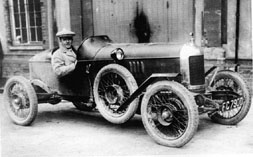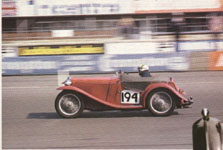|
|
|
|
|
|
|
|
|
|
|
|
|
|
 |
|
|
|
|
|
|
|
|
|
|
|
|
|
|
The Racing Breed
|
|
|
|
 |
|
 |
|
 |
|
 |
Cecil Kimber always the enthusiastic sportsman and a flair for publicity was keen to run his cars in competion. Prior to 1929, MG's racing record was anything but stellar. In the next five years , however, MG was to rock the racing fraternity. This was accomplished with great car setups, experienced drivers and the introduction of overhead camshaft engines. |
|
|
|
Kimber drove "Old Number One" to victory in the London-to Lands End Trial in 1925. |
|
|
 |
During the early thirties, MG won a number of racing's elite prizes. In 1930, a supercharged experimental car (Ex120) became the first 750 cc to break 100 mph. In 1931, at the Brooklands Double Twelve Race, C-type 750 cc Midgets took the first five places. It was heralded as one of the greatest triumphs by a single make in the history of motor racing. Competition successes were rewarding for both morale at the factory in Abingdon and for record sales of MGs. |
|
|
A K3 Magnette being driven at the Italian classic Mille Miglia in 1933. |
|
|
The most famous racing MG was the K3 Magnette. Equipped with a preselector gearbox it won numerous races. Two of the greatest races were the Tourist Trophy (Britains oldest road race) and the Mille Miglia (shown above) both in 1933. The team award at Mille Miglia was the first time it was won by a non Italian make. |
|
 |
|
|
|
The sale of William Morris' companies to the Nuffield Organization curtailed MG racing for a time. The racing legacy for the MG was far from being dead. |
|
|
|
|
|
The MG PA Midget was small but fast. The driver could expect a bumpy ride. |
|
|
|
 |
While the racing activities of the early thirties had changed, experimental cars and private sponsored racing continued on. Experimental and prototype cars were having tremendous success breaking land speed records. The second most famous MG racing car was the EX179. At the salt flats in Utah it set eight endurance records, reaching a top speed of 153.69 mph in 1954. By 1956, the EX179 had been reworked to achieve 16 international recors with speeds of up to 170.15 mph. |
|
|
Today MGs can still be seen racing in North America, Europe and all around the world by enthusiasts who enjoy safety fast. |
|
|
MGA with its racing heritage proved successful as well attaining numerous individual and team prizes. |
|
|
|
|
|
|
|
|
|















